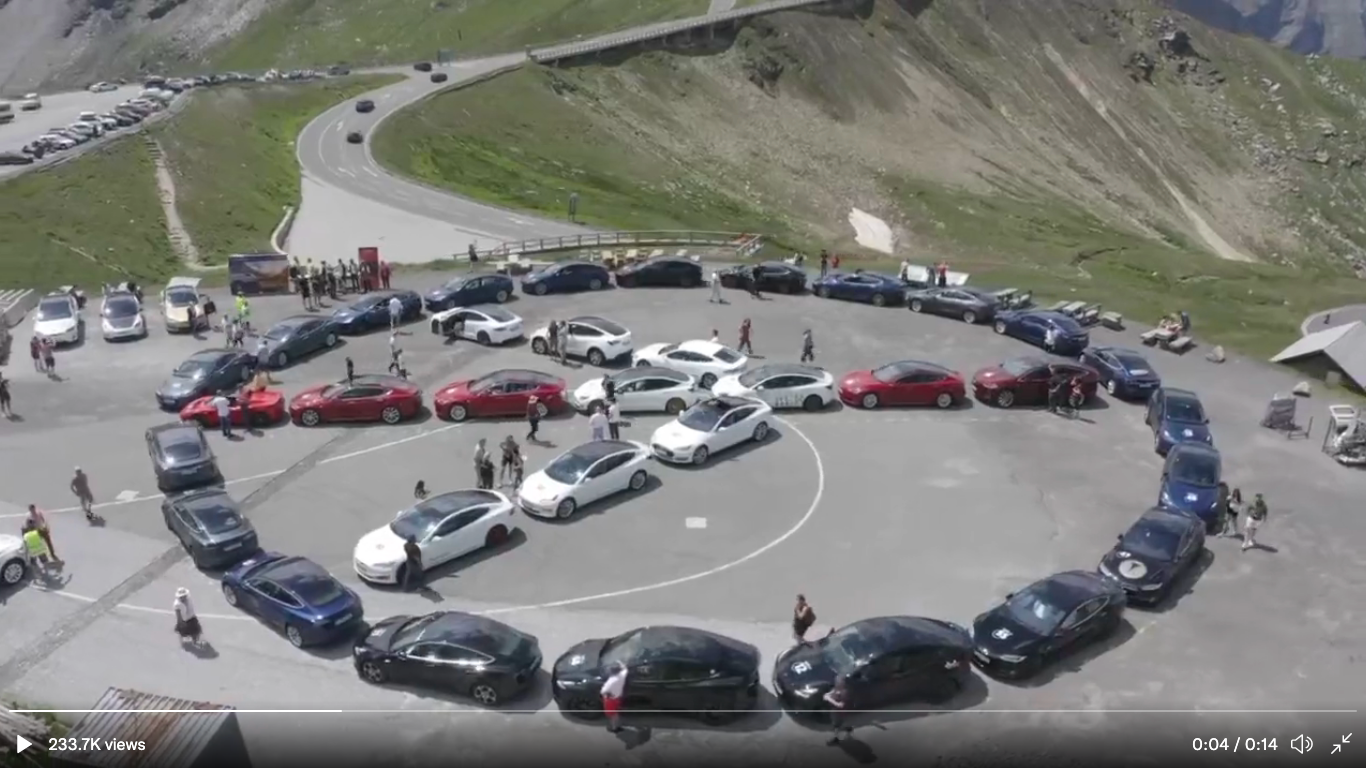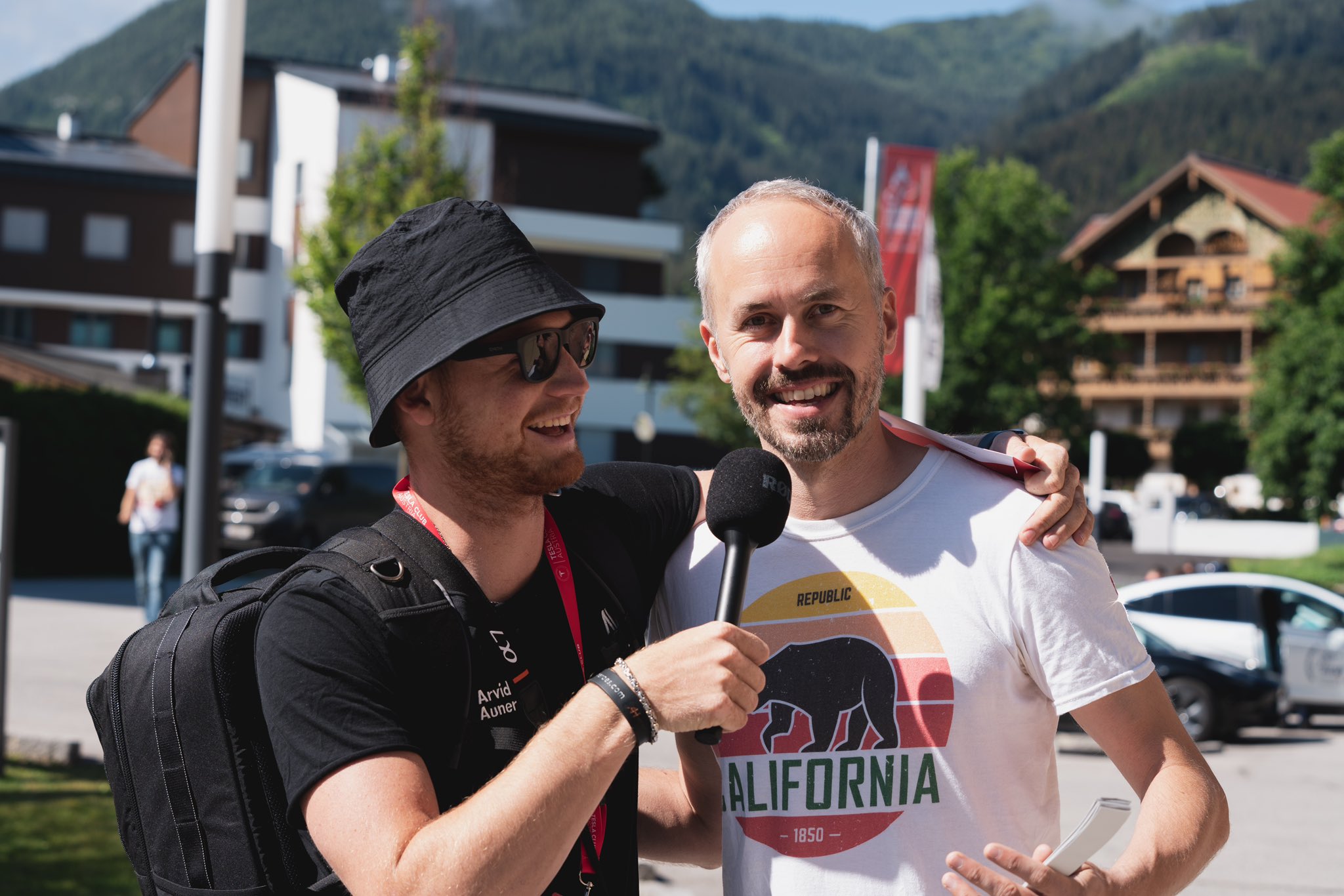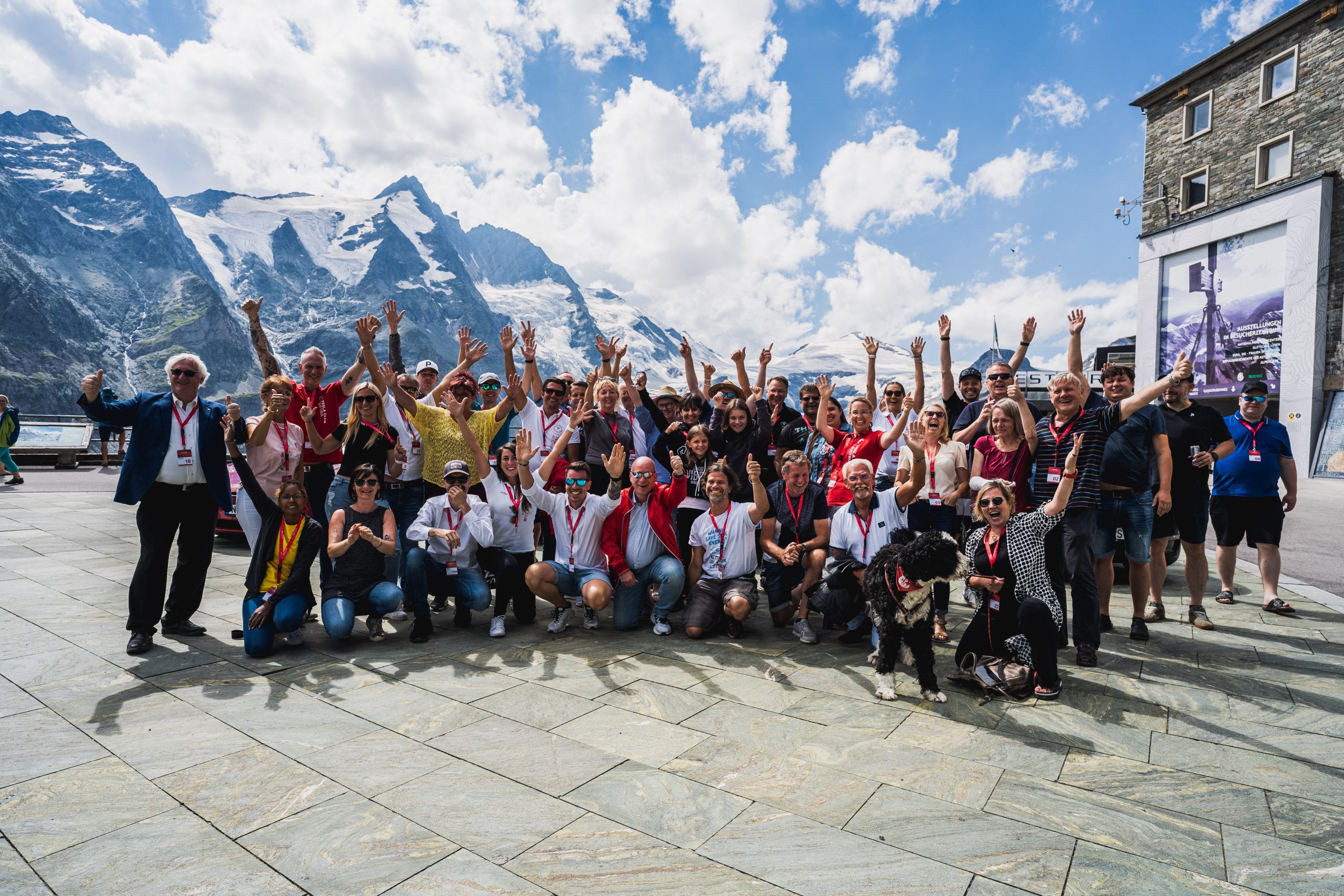

News
Tesla owners unite in Austria for epic Black Mountain meetup
Tesla owners from eight countries took electric vehicles to new heights as they drove to the top of the highest mountain in Austria. The Großglockner or ‘black mountain’ towers 3,798 meters above the surrounding mountains. According to legends, a black crystal concentrates the energy of the mountain and is hidden somewhere inside the Glockner.
Today with @TeslaClubAT we climbed the highest mountain in Austria with 60 Teslas from 8 countries 🇺🇸🇸🇪🇫🇮🇳🇴🇨🇭🇩🇪🇦🇹 and 🇺🇦
Supporting Peace, Love & Tesla @elonmusk #silencerallye @Tesla pic.twitter.com/DlnPgtxFR4— Tesla Owners Silicon Valley (@teslaownersSV) July 3, 2022
The Tesla Owners Club of Austria brought together 60 Tesla vehicles with owners from eight nations to share a powerful message. “Let’s work hard to preserve this and all other treasures on this planet,” they shared on Twitter.
The message is a symbol of peace. The club president of Tesla Owners of Silicon Valley represented the United States which had just celebrated its 246th Independence Day. The Tesla owners came together to support peace, love, and Tesla.
Austria is such an amazing, beautiful and S3XY country. It was a great honor to show it to 60 tesla drivers from 8 nations. Let’s work hard to preserve this and all other treasures on this planet 💪✌️🇦🇹😍 @elonmusk @teslaclubfin @OwnersWest @TeslaClubNorway @teslaownersSV pic.twitter.com/QjDtwmaWnH
— Tesla Club Austria (@TeslaClubAT) July 4, 2022
I reached out to the Tesla Owners Club of Austria and asked them to share how the experience was for them. They told me,
“I almost cried because in this time of crisis everywhere it felt so good to experience so much fun and love together with the Tesla community. We had 60 Teslas from 8 nations (including one team from Ukraine and club presidents from Sweden, Finland, Norway, and Silicon Valley), perfect weather, and great fun.”

“The Großglockner is the highest mountain in Austria and there are 300.000 cars every year driving the world-famous road. We wanted to show that you can do that without emissions, sexy and silent. You get so much energy back during regenerative braking while driving down so that was no problem at all charging all the 60 cars. And you get so many good feelings back when you participate in such events.”
Why They Chose The Peace Sign
It’s about building something new at events. The Tesla Owners Club of Austria participated in the Silence Rallye and chose the peace sign for a reason. The Rallye, they told me, is the club’s largest annual event.
“It is our biggest event and we organize it every year in a different region in Austria. There are fun competitions, amazing road trips, and good food for three days. This year we tried to bring some Sound of Music Style into it with a special VIP tour through Salzburg city and the Vintage Party. Großglockner is also in the Salzburg area so it was a Must that we had to climb this mountain.”

“We always try to build something new at our bigger events. After a Tesla Logo and a heart shape, it just felt right to do this sign. The theme of this Silence Rallye was Sound of Music because we visited Salzburg. We organized a vintage disco with Dresscode. Some people came as hippies so setting up the peace sign on one of the highest mountains in the Alps was a perfect way, to sum up, our Rallye.”

Supporting Ukraine
There was one team from Ukraine and the club wanted to show support. They also raised donations and helped Tesla drivers from Ukraine that were traveling to safer locations. The majority of the teams were from Austria, Switzerland, and Germany. Several club presidents from West Sweden, Finland, Norway, and Silicon Valley were also there.
John Stringer, the president of the Tesla Owners of Silicon Valley told me that the Austria club spent an extensive amount of time mapping out each car to get it perfect. He added,
“It was super cool to meet the owners of Austria and be able to take a Sound of Music tour and take 60 Teslas to the highest peak in Austria.”

Elon Musk
Elon Musk and Tesla AI Director share insights after empty driver seat Robotaxi rides
The executives’ unoccupied tests hint at the rapid progress of Tesla’s unsupervised Robotaxi efforts.

Tesla CEO Elon Musk and AI Director Ashok Elluswamy celebrated Christmas Eve by sharing personal experiences with Robotaxi vehicles that had no safety monitor or occupant in the driver’s seat. Musk described the system’s “perfect driving” around Austin, while Elluswamy posted video from the back seat, calling it “an amazing experience.”
The executives’ unoccupied tests hint at the rapid progress of Tesla’s unsupervised Robotaxi efforts.
Elon and Ashok’s firsthand Robotaxi insights
Prior to Musk and the Tesla AI Director’s posts, sightings of unmanned Teslas navigating public roads were widely shared on social media. One such vehicle was spotted in Austin, Texas, which Elon Musk acknowleged by stating that “Testing is underway with no occupants in the car.”
Based on his Christmas Eve post, Musk seemed to have tested an unmanned Tesla himself. “A Tesla with no safety monitor in the car and me sitting in the passenger seat took me all around Austin on Sunday with perfect driving,” Musk wrote in his post.
Elluswamy responded with a 2-minute video showing himself in the rear of an unmanned Tesla. The video featured the vehicle’s empty front seats, as well as its smooth handling through real-world traffic. He captioned his video with the words, “It’s an amazing experience!”
Towards Unsupervised operations
During an xAI Hackathon earlier this month, Elon Musk mentioned that Tesla owed be removing Safety Monitors from its Robotaxis in Austin in just three weeks. “Unsupervised is pretty much solved at this point. So there will be Tesla Robotaxis operating in Austin with no one in them. Not even anyone in the passenger seat in about three weeks,” he said. Musk echoed similar estimates at the 2025 Annual Shareholder Meeting and the Q3 2025 earnings call.
Considering the insights that were posted Musk and Elluswamy, it does appear that Tesla is working hard towards operating its Robotaxis with no safety monitors. This is quite impressive considering that the service was launched just earlier this year.
Elon Musk
Starlink passes 9 million active customers just weeks after hitting 8 million
The milestone highlights the accelerating growth of Starlink, which has now been adding over 20,000 new users per day.

SpaceX’s Starlink satellite internet service has continued its rapid global expansion, surpassing 9 million active customers just weeks after crossing the 8 million mark.
The milestone highlights the accelerating growth of Starlink, which has now been adding over 20,000 new users per day.
9 million customers
In a post on X, SpaceX stated that Starlink now serves over 9 million active users across 155 countries, territories, and markets. The company reached 8 million customers in early November, meaning it added roughly 1 million subscribers in under seven weeks, or about 21,275 new users on average per day.
“Starlink is connecting more than 9M active customers with high-speed internet across 155 countries, territories, and many other markets,” Starlink wrote in a post on its official X account. SpaceX President Gwynne Shotwell also celebrated the milestone on X. “A huge thank you to all of our customers and congrats to the Starlink team for such an incredible product,” she wrote.
That growth rate reflects both rising demand for broadband in underserved regions and Starlink’s expanding satellite constellation, which now includes more than 9,000 low-Earth-orbit satellites designed to deliver high-speed, low-latency internet worldwide.
Starlink’s momentum
Starlink’s momentum has been building up. SpaceX reported 4.6 million Starlink customers in December 2024, followed by 7 million by August 2025, and 8 million customers in November. Independent data also suggests Starlink usage is rising sharply, with Cloudflare reporting that global web traffic from Starlink users more than doubled in 2025, as noted in an Insider report.
Starlink’s momentum is increasingly tied to SpaceX’s broader financial outlook. Elon Musk has said the satellite network is “by far” the company’s largest revenue driver, and reports suggest SpaceX may be positioning itself for an initial public offering as soon as next year, with valuations estimated as high as $1.5 trillion. Musk has also suggested in the past that Starlink could have its own IPO in the future.
News
NVIDIA Director of Robotics: Tesla FSD v14 is the first AI to pass the “Physical Turing Test”
After testing FSD v14, Fan stated that his experience with FSD felt magical at first, but it soon started to feel like a routine.

NVIDIA Director of Robotics Jim Fan has praised Tesla’s Full Self-Driving (Supervised) v14 as the first AI to pass what he described as a “Physical Turing Test.”
After testing FSD v14, Fan stated that his experience with FSD felt magical at first, but it soon started to feel like a routine. And just like smartphones today, removing it now would “actively hurt.”
Jim Fan’s hands-on FSD v14 impressions
Fan, a leading researcher in embodied AI who is currently solving Physical AI at NVIDIA and spearheading the company’s Project GR00T initiative, noted that he actually was late to the Tesla game. He was, however, one of the first to try out FSD v14.
“I was very late to own a Tesla but among the earliest to try out FSD v14. It’s perhaps the first time I experience an AI that passes the Physical Turing Test: after a long day at work, you press a button, lay back, and couldn’t tell if a neural net or a human drove you home,” Fan wrote in a post on X.
Fan added: “Despite knowing exactly how robot learning works, I still find it magical watching the steering wheel turn by itself. First it feels surreal, next it becomes routine. Then, like the smartphone, taking it away actively hurts. This is how humanity gets rewired and glued to god-like technologies.”
The Physical Turing Test
The original Turing Test was conceived by Alan Turing in 1950, and it was aimed at determining if a machine could exhibit behavior that is equivalent to or indistinguishable from a human. By focusing on text-based conversations, the original Turing Test set a high bar for natural language processing and machine learning.
This test has been passed by today’s large language models. However, the capability to converse in a humanlike manner is a completely different challenge from performing real-world problem-solving or physical interactions. Thus, Fan introduced the Physical Turing Test, which challenges AI systems to demonstrate intelligence through physical actions.
Based on Fan’s comments, Tesla has demonstrated these intelligent physical actions with FSD v14. Elon Musk agreed with the NVIDIA executive, stating in a post on X that with FSD v14, “you can sense the sentience maturing.” Musk also praised Tesla AI, calling it the best “real-world AI” today.








